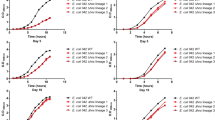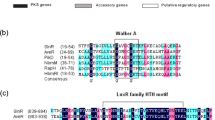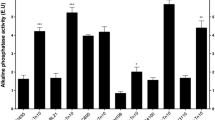Abstract
Inhibition of cell division associated with overexpression of hisH and hisF in Salmonella typhimurium is strongly reminiscent of a cellular response to DNA damage. On these grounds, we investigated the involvement of a metabolite which appeared to represent a possible candidate for an endogenous mutagen: the base analog 5-amino-4-carboxamide imidazole riboside 5′-phosphate (AICAR), a by-product of HisH and HisF activity. However, we showed that AICAR is not an endogenous mutagen in S. typhimurium. Other types of DNA damage induced by his overexpression seem also unlikely, since similar mutation rates are found in hisO + and hisO c strains. We also show that AICAR production is not involved in the pleiotropic effects of his overexpression, since these are still observed in strains devoid of AICAR. Thus inhibition of cell division resulting from HisH and HisF overexpression must operate through a mechanism unrelated to the role of these proteins in histidine biosynthesis.
Similar content being viewed by others
References
Antón DN (1979) Positive selection of mutants with cell envelope defects in a Salmonella typhimurium strain hypersensitive to the products of genes hisH and hisF. J Bacteriol 137:1271–1281
Bochner BR, Ames BN (1982) ZTP (5-amino-4-imidazole carboxamide riboside 5′-triphosphate): a proposed alarmone for 10-formyl-tetrahydrofolate deficiency. Cell 29:929–937
Brown DA, D'Ari R, Newman EB (1990) A relationship between l-serine degradation and methionine biosynthesis in Escherichia coli K12. J Gen Microbiol 136:1017–1023
Casadesús J, Roth JR (1989) Absence of insertions among spontaneous mutants of Salmonella typhimurium. Mol Gen Genet 216:210–216
Chan RK, Botstein D, Watanabe T, Ogata Y (1972) Specialized transduction of tetracycline by phage P22 in Salmonella typhimurium. II. Properties of a high frequency transducing lysate. Virology 50:883–898
Cupples CG, Miller JH (1989) A set of 1acZ mutations in Escherichia coli that allow rapid detection of each of the six base substitutions. Proc Natl Acad Sci USA 86:5345–5349
Downs DM (1987) Purine metabolism and cryptic prophages in Salmonella typhimurium. Ph. D. Thesis, University of Utah, Salt Lake City
Fink GR, Klopotowski T, Ames BN (1967) Histidine regulatory mutants in Salmonella typhimurium. IV. A positive selection for polar histidine-requiring mutants from histidine operator constitutive mutants. J Mol Biol 30:81–95
Fox M, Frandsen N, D'Ari R (1993) AICAR is not and endogenous mutagen in Escherichia coli. Mol Gen Genet 240:355–359
Frandsen N, D'Ari R (1993) Excess histidine enzymes cause AICAR-independent filamentation in Escherichia coli. Mol Gen Genet 240:348–354
Geiger JR, Speyer JF (1977) A conditional antimutator in E. coli. Mol Gen Genet 153:87–97
Gibert I, Casadesús J (1990) sulA-independent division inhibition in His-constitutive strains of Salmonella typhimurium. FEMS Microbiol Letters 69:205–210
Johnston HM, Roth JR (1981) Genetic analysis of the histidine operon control region of Salmonella typhimurium. J Mol Biol 145:713–734
Maloy SR (1990) Experimental techniques in bacterial genetics. Jones and Bartlett Publishers, Boston
Murray ML, Hartman PE (1972) Overproduction of hisH and hisF gene products leads to inhibition of cell division in Salmonella. Can J Microbiol 18:671–681
Neuhard J, Nygaard P (1987) Purines and pyrimidines. In: Neidhardt FC, Ingraham JL, Low KB, Magasanik B, Schaechter M, Umbarger HE (eds) Escherichia coli and Salmonella typhimurium: Cellular and Molecular Biology. American Society for Microbiology, Washington DC, pp 445–473
Sabina RL, Holmes EW, Becker MA (1984) The enzymatic synthesis of 5-amino-4-imidazolecarboxamide riboside triphosphate (ZTP). Science 223:1193–1195
Sanderson KE, Roth JR (1988) Linkage map of Salmonella typhimurium. Edition VII. Microbiol Rev 52:485–532
Schmieger H (1972) Phage P22 mutants with increased or decreased transducing abilities. Mol Gen Genet 119:75–88
Schmid MB, Roth JR (1983) Internal promoters of the his operon in Salmonella typhimurium. J Bacteriol 153:1114–1119
Shanabruch WG, Behlau I, Walker GC (1981) Spontaneous mutators of Salmonella typhimurium LT2 generated by insertion of transposable elements. J Bacteriol 147:827–835
Sheppard DE (1964) Mutants of Salmonella typhimurium resistant to feedback inhibition by l-histidine. Genetics 50:611–623
Vogel H, Bonner D (1956) Acetylornithase of Escherichia coli: partial purification and some properties. J Biol Chem 218:97–106
Winkler ME (1987) Biosynthesis of histidine. In: Neidhardt FC, Ingraham JL, Low KB, Magasanik B, Schaechter M, Umbarger HE (eds) Escherichia coli and Salmonella typhimurium: Cellular and Molecular Biology. American Society for Microbiology, Washington DC, pp 395–411
Author information
Authors and Affiliations
Additional information
Communicated by R. Devoret
Rights and permissions
About this article
Cite this article
Flores, A., Fox, M. & Casadesús, J. The pleiotropic effects of his overexpression in Salmonella typhimurium do not involve AICAR-induced mutagenesis. Molec. Gen. Genet. 240, 360–364 (1993). https://doi.org/10.1007/BF00280387
Received:
Accepted:
Issue Date:
DOI: https://doi.org/10.1007/BF00280387




